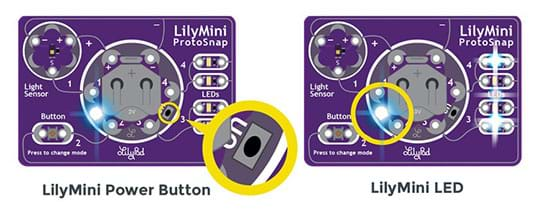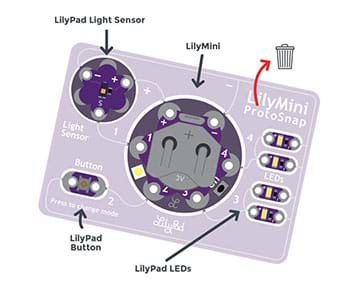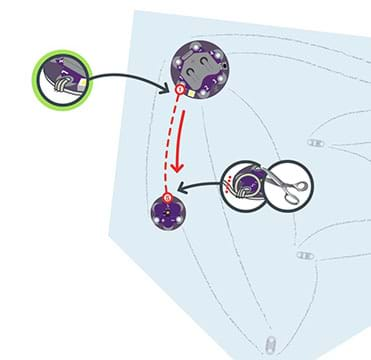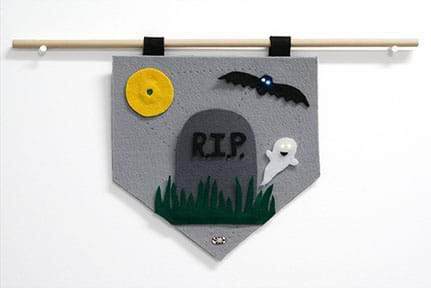Quick Look
Grade Level: 5 (4-6)
Time Required: 3 hours 30 minutes
(can be split into different days)
Expendable Cost/Group: US $20.00 This activity also uses some non-expendable (reusable) supplies; see the Materials List for details.
Group Size: 1
Activity Dependency: None
Subject Areas: Computer Science
NGSS Performance Expectations:

| 4-PS3-2 |

Summary
Students learn the functions of pre-programmed microcontroller units such as the LilyMini ProtoSnap as they use them to create light-up pennants with LED components. Students design their own felt pennants and sew on circuit components using conductive thread. This activity gives students hands-on experience with engineering technologies while making creative pennants with LED lights that can illuminate in three pre-programmed sequences: all on, breathing, and twinkle.Engineering Connection
Electrical engineers use microcontrollers to control individual components in a system. They can be programmed in advance with different sequences of code to control component behaviors. Microcontrollers are used in so many different applications, ranging from medical equipment to automobiles, and are an example of how engineering technologies are present in our everyday lives.
Learning Objectives
After this activity, students should be able to:
- Explain what microcontrollers do.
- Describe the importance of microcontrollers in engineering and artistic applications.
- Assemble a system based on the LilyPad LilyMini microcontroller unit.
Educational Standards
Each TeachEngineering lesson or activity is correlated to one or more K-12 science,
technology, engineering or math (STEM) educational standards.
All 100,000+ K-12 STEM standards covered in TeachEngineering are collected, maintained and packaged by the Achievement Standards Network (ASN),
a project of D2L (www.achievementstandards.org).
In the ASN, standards are hierarchically structured: first by source; e.g., by state; within source by type; e.g., science or mathematics;
within type by subtype, then by grade, etc.
Each TeachEngineering lesson or activity is correlated to one or more K-12 science, technology, engineering or math (STEM) educational standards.
All 100,000+ K-12 STEM standards covered in TeachEngineering are collected, maintained and packaged by the Achievement Standards Network (ASN), a project of D2L (www.achievementstandards.org).
In the ASN, standards are hierarchically structured: first by source; e.g., by state; within source by type; e.g., science or mathematics; within type by subtype, then by grade, etc.
NGSS: Next Generation Science Standards - Science
| NGSS Performance Expectation | ||
|---|---|---|
|
4-PS3-2. Make observations to provide evidence that energy can be transferred from place to place by sound, light, heat, and electric currents. (Grade 4) Do you agree with this alignment? |
||
| Click to view other curriculum aligned to this Performance Expectation | ||
| This activity focuses on the following Three Dimensional Learning aspects of NGSS: | ||
| Science & Engineering Practices | Disciplinary Core Ideas | Crosscutting Concepts |
| Make observations to produce data to serve as the basis for evidence for an explanation of a phenomenon or test a design solution. Alignment agreement: | Energy can be moved from place to place by moving objects or through sound, light, or electric currents. Alignment agreement: Energy is present whenever there are moving objects, sound, light, or heat. When objects collide, energy can be transferred from one object to another, thereby changing their motion. In such collisions, some energy is typically also transferred to the surrounding air; as a result, the air gets heated and sound is produced.Alignment agreement: Light also transfers energy from place to place.Alignment agreement: Energy can also be transferred from place to place by electric currents, which can then be used locally to produce motion, sound, heat, or light. The currents may have been produced to begin with by transforming the energy of motion into electrical energy.Alignment agreement: | Energy can be transferred in various ways and between objects. Alignment agreement: |
International Technology and Engineering Educators Association - Technology
-
Follow directions to complete a technological task.
(Grades
3 -
5)
More Details
Do you agree with this alignment?
-
Explain how technology and engineering are closely linked to creativity, which can result in both intended and unintended innovations.
(Grades
6 -
8)
More Details
Do you agree with this alignment?
State Standards
Colorado - Science
-
Show that electricity in circuits requires a complete loop through which current can pass
(Grade
4)
More Details
Do you agree with this alignment?
Materials List
Each student/group needs:
- LilyPad LilyMini ProtoSnap (includes microcontroller, light sensor, mode button, battery, CR2032 battery holder, RGB LEDs), such as DEV-14063 for $15 from SparkFun at https://www.sparkfun.com/products/14063
- sewing needle, such as from a set of five needles for $2 from SparkFun at https://www.sparkfun.com/products/10405
- Pennant Template
- craft felt, one 9 x12-inch sheet makes one pennant
- wooden dowel rod, on which to hang the pennant from felt loops
To share with the entire class:
- conductive thread, 2+ feet per student; such as 30-ft stainless steel thread bobbin for $3 from SparkFun at https://www.sparkfun.com/products/10867
- pens, markers or chalk to trace design on felt
- scissors
- embroidery or sewing thread
- hot glue gun(s) and hot glue sticks
- (optional) assorted additional craft supplies for decorating, such as feathers, sequins and buttons
- (optional) string and push pins, to hang the pennants on a wall
Worksheets and Attachments
Visit [www.teachengineering.org/activities/view/spfun-1876-night-light-pennant-lilymini-protosnap] to print or download.Pre-Req Knowledge
Basic understanding of circuits. Ability to hand sew using needle and thread.
Introduction/Motivation
How do we control systems? Most of the time, systems rely on user input to work; like pushing a button or flipping a switch. We can also control systems using a computer, which enables us to give a wide variety of instructions to our systems. Today, we will be using LilyMini microcontrollers to control small lights called LEDs. A microcontroller is a small computer that stores information and commands, so our LEDs can have more advanced behavior than simply turning on and off.
Besides LEDs, what do you think engineers use microcontrollers for? (Discuss ideas as a class.) Microcontrollers are present in everything from household appliances to automobiles! Engineers pre-program the controllers with programming code, so that users can easily control more-complex systems.
Microcontrollers and electronics are being used more often in textiles, fashion and toys. Can you think of any items that contain electronics? (Possible answers: Light-up shoes, shirts and keychains, stuffed animals that move and sing.) Today, you will act as if you are electrical engineers and create hanging pennants that have LED components. The LilyMini microcontroller you will use is specifically for textiles, and you will sew it onto your pennants using conductive thread. Let’s get started!

Procedure
Background
If unfamiliar with e-textiles, take a look at the following SparkFun tutorials,
Before the Activity
- Make copies of the Pennant Template, one per student.
- Cut the conductive thread into 2-foot (0.6-m) strands, one per student.
- Gather the remaining materials.
- Heat up the glue guns.
With the Students
- Present to the class the Introduction/Motivation section. Incorporate the pre-activity assessment—a discussion of everyday uses of microcontrollers.
- Distribute the batteries and LilyMini ProtoSnap boards. Direct students not to break the boards apart (yet).
- Tell the students: The LilyMini Protosnap has all its components wired together so you can test out the circuit’s functions before you sew. Install the battery and press the “on/off” button located between sew tabs 3 and 4 (as necessary, show Figure 1).

- Direct students to explore the different modes of the LilyMini by pressing the button and covering the light sensor. Expect them to discover the colors and behaviors for the following three modes:
Mode 1 = white lights; all LEDs on
Mode 2 = magenta lights; LEDs fade in and out in a breathing pattern; when the light sensor is covered, the LEDs fade faster
Mode 3 = cyan (blue) lights; LEDs off; when the light sensor is covered, the LEDs twinkle
- Review the definitions of outputs and inputs. Ask students to identify the outputs and inputs of their circuits. (Outputs = the LEDs; inputs = light sensor and button.)
- Hand out the remaining supplies.
- Have students trace the Pennant Template onto their felt pieces and cut them out.
- Direct students to break apart the LilyMinis and discard the non-sewable pieces and scraps (see Figure 2). Then remove the battery and set it aside somewhere out of the way.

- Direct students to arrange their circuits’ components on their felt pennants according to the template’s diagram instructions. Have students trace the circuit to sew, keeping track of positive and negative terminal orientation. Once everything is laid out and the orientations are double-checked, direct students to use drops of hot glue to secure each component in place.
- Then have students use conductive thread to sew the circuit components to the felt piece.
- Make sure students loop the thread through each component at least three times to ensure electrical connections. Figure 3 shows an example of sewing tab 1 of the LilyMini to tab S of the light sensor.

- Direct students to continue sewing the components together according to the template. Have students use one long piece of conductive thread to connect multiple components, such as the negative terminals of the LEDs.
- Tell the students: After all the stitching is complete, turn over the project and trim any loose thread tails before testing.
- Have students insert the battery and check all the circuit modes. If any problems are encountered, see the Troubleshooting Tips section.
- Have students customize and decorate their pennants using whatever craft supplies are available, including cutting and gluing shapes and letters cut from excess felt (trade colors with other students).
Tips:
- The light sensor must remain uncovered to work!
- Incorporate into your designs the light-up LED locations.
- Covering the LEDs will dull the light, so keep that in mind while decorating.

- Conclude by having students individually present their pennants to the class, as described in the Assessment section.
Vocabulary/Definitions
conductive thread: Thread spun of stainless steel (or silver-coated nylon) that carries current like wires so that it can be used to create circuits that are flexible and require no soldering and thus are suitable for textile-based projects that use embedded electronics. Conductive thread tends to be more “twisty,” and so more difficult to sew with than non-conductive (regular) thread.
e-textiles: Clothing or accessories that includes electrical components such as LEDs. Sometimes called electronic textiles, smart fabrics, smart textiles, smart clothing or smart garments.
input/output: The communication between an information processing system (such as a computer) and the outside world. Input is the circuit component that gathers information from the world and relays it to the microcontroller. Output is a circuit component that receives information from a microcontroller and sends it out into the world.
LED: Abbreviation for light-emitting diode, which is a type of semiconductor called a diode that converts electrical energy into light.
microcontroller: A small computer that stores information and commands to control different sensors and boards it is connected to.
Assessment
Pre-Activity Assessment
Think-Pair-Share: Extend the Introduction/Motivation discussion of microcontrollers. Have students think of and then share within small groups their ideas of engineering applications in which microcontrollers might be useful. Discuss as a class.
Activity Embedded Assessment
Monitoring: Walk around the classroom while students sew together the LilyMini components. Help with any troubleshooting needs that arise.
Post-Activity Assessment
Class Presentations: Give students time to show off their completed and decorated pennants and compare their designs. What are some advantages and disadvantages to the way the pennants are designed?
Beyond Pennants: In a class discussion format, ask students: For what other applications engineers might use the LilyMini ProtoSnap?
Safety Issues
- Hot glue may cause minor burns so make sure students handle glue guns with care.
- Sharp sewing needles can cause injury if used carelessly. Advise students to use them with intention and be especially careful around their faces and eyes.
- Breaking apart the LilyMini sometimes results in pieces with sharp edges so alert students to be careful when performing these steps.
Troubleshooting Tips
If a circuit does not light up, try a new battery or check that it is switched on. Then check the sewing for any loose threads or ends that may be touching other parts of the circuit and causing a short circuit.
Activity Extensions
Have students create new pennants without the provided template. Student-made templates reveal their comprehension of circuits and open up the project for more creativity.
Activity Scaling
- For lower grades, pre-cut the felt templates and have students instruct adult helpers on where to place dots of hot glue. Also have adults break apart the LilyMini ProtoSnaps for the students. Spend less time exploring the functions of the LilyMini pre-assembly and provide more time for pennant customization.
- For higher grades, eliminate the provided template and have students design their own circuit designs. Direct students to clearly label the components and require them to get approval of their circuits before they begin assembly.
Subscribe
Get the inside scoop on all things TeachEngineering such as new site features, curriculum updates, video releases, and more by signing up for our newsletter!More Curriculum Like This

Students learn how to set up pre-programmed microcontroller units like the Arduino LilyPad and use them to enhance a product’s functionality and personality. They do this by making plush toys in monster shapes (template provided) with microcontrollers and LEDs sewn into the felt fabric with conducti...

Students make design decisions about controlling LEDs in a light-up, e-textile circuit, plush toy project made using LilyPad ProtoSnap components and conductive thread. They follow instructions to assemble a product while applying their own creativity to customize it. In this sewable electronics pro...

Students learn about engineering applications in artistic venues by designing and creating eye masks that each contain three LEDs. They explore parallel circuits with their LEDs, and sew with conductive thread to create light-up displays on their masks, gaining hands-on experience in using engineeri...
References
Activity adapted from SparkFun’s Night-Light Pennant with LilyMini ProtoSnap at https://learn.sparkfun.com/tutorials/night-light-pennant-with-lilymini-protosnap/introduction
Copyright
© 2017 by Regents of the University of Colorado; original © 2016 SparkFun EducationContributors
Angela Sheehan; Sabina SchillSupporting Program
SparkFun EducationLast modified: October 25, 2021








User Comments & Tips